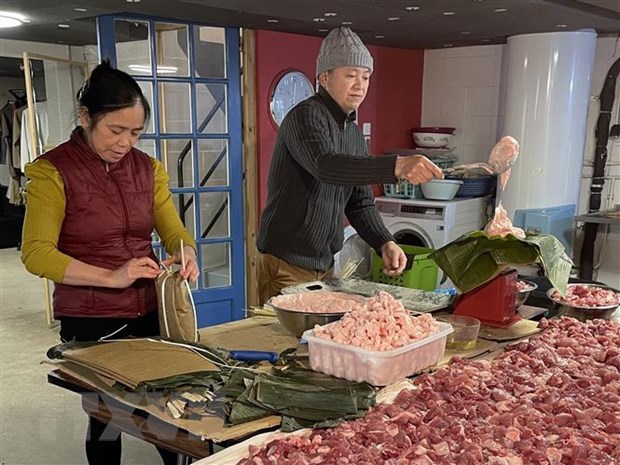 Society
Society


|
| A Vietnamese family in Vitré make chưng cake (square sticky rice cake), a traditional New Year cake of Việt Nam. — VNA/VNS Photo |
VITRÉ — Every year head of Tết (Lunar New Year) holiday, the family of Lê Anh Tuấn, an overseas Vietnamese living in Vitré, France, gathers to make two traditional Vietnamese dishes.
Vitré is a small town in the northwest of France. It is home to about 40 Vietnamese families. From a group of young people working at local meat processing factories, after 20 years the Vietnamese community in Vitré has expanded.
This year although all festive activities of the Vietnamese community in France have been cancelled due to the pandemic, Tuấn’s family still preserves the tradition of making chưng cake (square sticky rice cake) and giò (pork roll).
He and his wife went shopping to buy sticky rice, green beans, dong leaves and bamboo strings.
Tuấn said despite the pandemic, it was not difficult to buy ingredients imported from Việt Nam to make chưng cake.
“This year the Vietnamese Association in Vitré will not hold any New Year celebrations. But the family still decided to make chưng cake because it is the tradition of Vietnamese people,” he told Vietnamplus.
“The Vietnamese community in Vitré could not gather to celebrate Lunar New Year for two years due to COVID-19. But Vietnamese families here still make chưng cake and giò to remind children of their traditional New Year dishes.”
This year Tuấn’s family made the cake with the family of Nguyễn Xuân Cường, a Vietnamese family living next door. The two families made 50 cakes for themselves and presents.
Cường said wrapping the cake made them remember their homeland. He started to make the first cake two years ago and has got fast in every step such as spreading the leaves, pouring the rice, arranging the meat and wrapping.
In just a few minutes, he can complete the making of a square cake.
“The signature of chưng cake made in Vitré is pork. Pigs here are raised with milk for six months before slaughter, so the meat has a pink and white colour, making the cake more moist and tasty,” Cường said.
After a morning, 50 cakes are completed and put on the stove for boiling.
Tuấn said the cakes are steamed by a gas stove, not by charcoal. “That makes the work less tough but we do not have the atmosphere of everyone gathering like in Việt Nam,” he said.
Meanwhile, Nguyễn Văn Nguyên and his wife Nguyễn Thị Lương are making giò.
On normal days, his family only makes giò if there are orders.
Nguyên said pork must be carefully selected and fresh. Vitré is a production and processing area for meat and poultry, so the pork in the region is better than elsewhere.

|
| Overseas Vietnamese in Vitré wrap Vietnamese pork rolls with banana leaves imported from Việt Nam. — VNA/VNS Photo |
If you want to make chưng cake green, you must wrap it with dong leaves, and if you want giò to be delicious, you must wrap it with banana leaves.
Imported banana leaves in Vitré are expensive. There are three levels of prices for giò: the most expensive is for those made from frozen banana leaves imported from Việt Nam; the second most expensive is made by moulds and one layer of banana leaves; the cheapest are wrapped in plastic. — VNS




